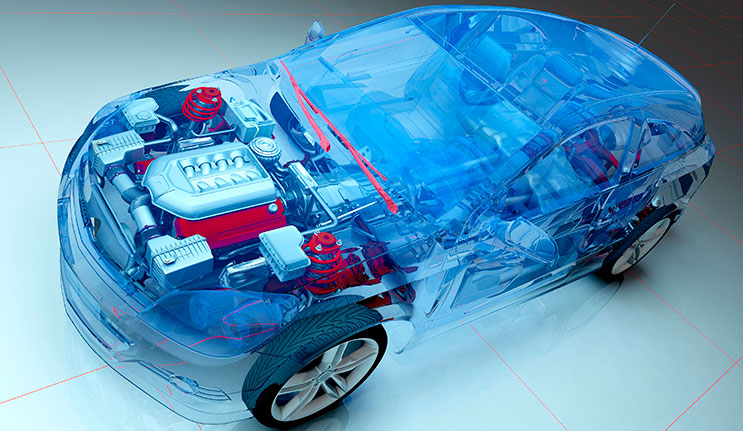What’s the current status of your tire’s tread? What about your windshield wipers? Many respectable car owners can’t answer these questions (so don’t feel too bad). However, not knowing could actually be damaging your car’s internal and external parts.
Today’s cars are durable and generally reliable, yet a driver’s behavior and lack of “car smarts” can rapidly increase wear and tear of individual parts and eventually the car as a whole. Protect yourself and one of your biggest and most important investments by performing regular maintenance checks and following the four rules outlined below.
Not Using the Parking Brake
The parking brake myths started in the early days of driving, from “off-road vehicles are designed for hills, they don’t need to use parking brakes” to “little automatic cars aren’t going anywhere.” Unfortunately, your mother (at least in my case) was the only truth-teller here: drivers should always use their parking brakes. The reason why, however, may be new information.
Putting a car in brake engages a small metal pin, the parking pawl, that disengages the transmission’s output and places the car’s weight on the pawl. When parked at an incline, the weight of the car’s pressure may be awkwardly or unevenly distributed, leading to a premature wear on the pawl. As a reminder, the average weight of a car is over 4,000 pounds- it’s a lot of weight on a small pin. However, the parking brake immobilizes the wheels, lessening the burden on and protecting the pawl.
Replacing brakes can be expensive enough, so at the least, protect your parking pawl. To replace a damaged one, a mechanic must remove the car’s transmission and open up the pawl’s casing. Experts say a “good deal” is anything around $500.
Driving on “Empty”
Daredevils and gas station haters alike frequently test their car’s limits by seeing just how far they can travel on empty. But rolling into a gas station can lead to serious internal problems for your car. Driving with your gas light on damages the car’s fuel pump, an electric tool designed to remain immersed in fuel. Once exposed, the pump begins to overheat, cooling down only after reimmersion. This constant overheating to cooling process creates car and money problems. A replacement pump with labor can cost upwards of $600. Use that price tag as motivation to visit the gas station once your tank is one-fourth to one-eighth full.
Perhaps more importantly though, running out of gas while driving on a busy road or highway could place you in great danger, even leading to death. I asked Miami car accident lawyer David Lipcon to explain some of the tragic yet preventable accidents he’s seen in relation to these four points. As a car sucks up the last drops of fuel, it begins to stall until coming to a stop. Stalling or stranded, he said, is a familiar beginning to many car accidents. When a driver is forced to stop or pullover on the side of a road, their chances of being involved in a car accident—either in their car or as a pedestrian—increase exponentially.
Ignoring Old Windshield Wipers
Though it may vary based on climate, windshield wipers should be replaced annually, usually before fall or winter when the rainy season begins. If your car is always parked outside or if you live in warmer climates, wipers may need to be changed every six months. Sometimes you can just change the blades, while other times you’ll need the full wipers. Luckily, this is one of the cheaper car “repairs.” Wipers average $12 to $20, sold individually. Failing to change wipers will eventually lead to diminished visibility and scratched windows.
Thinking Tires are Immortal
Many drivers treat their tires like their annual check-up: ignore until something goes wrong. Tire failure is responsible for around 11,000 accidents annually, according to the National Highway Traffic Safety Administration. To stay safe, responsible drivers should rotate their tires every 5,000 miles (or at least with every oil change) and check their tires monthly for four things, discussed below.
- Bulges or cracks: Generally, when a tire deflates it bulges at the sides. It’s usually a sign of low tire pressure (discussed later) or a leak and should be checked by a mechanic. Also check for cracks, grooves or other odd changes in the tire’s appearance.
- Tire Pressure: Driving with underinflated tires can increase braking times, decrease steering control and diminish gas mileage. Continue driving this way and you’ll likely end up buying new tires sooner than expected due to premature wear. This may not need to occur on a monthly basis, but do check your tire pressure frequently. Bonus tip: tire pressure often changes with the temperature—dropping in the cold and expanding in the heat—so it’s important to be aware of weather conditions within your daily commute and when going on road trips.
- Tread: If the tire’s tread pattern is worn down, it’s time for new tires. Most new tires come with wear bars, rubber inserted into the tread pattern at a specific depth. Once the rubber is visible, the tires need to be replaced. Rotating tires every 5,000 miles will help the tread last longer as the car places pressure differently on front and back tires.
- Vibration: If there’s a vibration while driving, always take a car to a trusted mechanic. Vibrations from the steering wheel could signal alignment or suspension issues while vibrating seats may mean the rear tires are out of balance.
Old and new drivers alike should take the time to get to know their tires. Can you name the different tire parts? Do you understand all the above points? What kind of tire is on your car right now? You’re not alone if you can’t answer some or all of these questions. A 2015 survey by the Rubber Manufacturers Association found 83 percent of drivers aren’t “tire smart.”
Work your way out of that statistic and up your car safety knowledge before it’s too late. Whether it be extensive and expensive car part failures or an accident from faulty wipers or tires, staying ahead of the game as we approach harsher winter seasons will help keep your spirit (and self) merrier.
About the Author
 Jenna Murrell is a digital marketing specialist with Safer America, a consumer safety organization. Through data visualizations, interactive content and blogging, we’re working towards bringing safety into everyday conversations.
Jenna Murrell is a digital marketing specialist with Safer America, a consumer safety organization. Through data visualizations, interactive content and blogging, we’re working towards bringing safety into everyday conversations.
Protect your employees with these training courses on driver safety:
Defensive Driving – Small Vehicles
Defensive Driving – Large Vehicles
Failure to Yield – Small Vehicles



